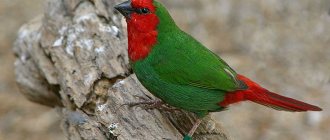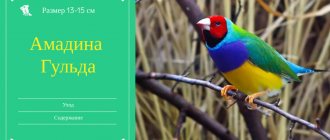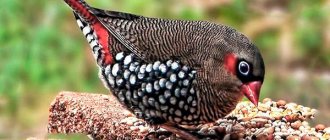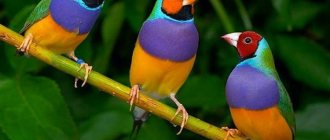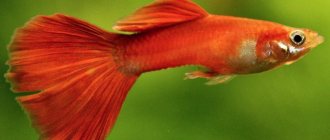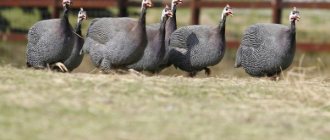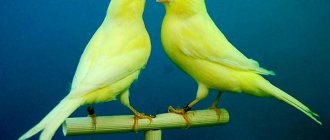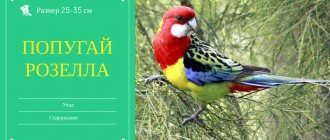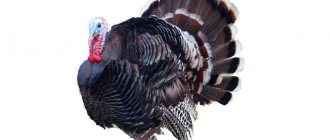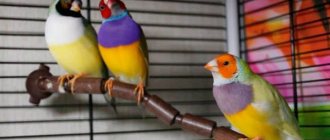Miniature finch birds as pets are an excellent alternative to small parrots. For example, zebra finches are one of the most popular songbirds. They are cheerful, noisy and active, but these qualities can not only delight us, but also irritate us. It is so interesting to watch the activities of finches, listen to expressive singing, and be touched by their touching care for each other. However, “minke whales” will never become tame, and in addition, they are aggressive towards birds of other species. We’ll talk about the most interesting features of zebra finches below.
Description, appearance
Zebra finches (lat. Taeniopygia guttata) are miniature birds from the family of finch weavers, belonging to the order Passeriformes. Their body length does not exceed 13-15 cm, and their weight is 50 g.
They have an expressive, thick and curved bright beak (red in males, pale orange in females and dark gray or black in chicks), which appears translucent from the outside. Small thin legs are colored bright orange.
The plumage of zebra finches is dense and motley. In males, a characteristic feature in color is a series of light and black stripes on the chest and tail, thanks to which the birds received the name “zebra”. Primary plumage colors: gray, orange, black and white.
- Gray top: head, wings, back.
- White belly.
- Orange cheeks and areas under the wings.
- Black stripes near the beak, under the eyes.
- Zebra stripes on the neck.
What colors of birds would you like to breed (photo from the Internet):
black-faced black-breasted fawn lightback | black-faced silver lightback | black-faced black-chested orange-chested lightback | marmaset triblack continental marmaset triblack |
Life in freedom
Zebra finches are gregarious birds. Their range extends to the entire region of Australia (with the exception of the northern regions), Africa, southern Asia and the Lesser Sunda Islands. They are also found in the USA, Portugal, and Puerto Rico, where finches were brought by sailors.
In nature, they prefer to settle near bodies of water in thickets of bushes, in the crowns of trees in flat areas, and in tall grass. Finches also get along well next to people in city parks. They feed on the seeds of various plants and grasses.
During the nesting period, they form pairs within the flock (up to 20-25 pairs in one flock at the same time). Zebra finches nest wherever they can: in hollows and treetops, in empty nests made by other birds, and even in rabbit holes.
How zebra finches sing
Finches are classified as songbirds, although the zebra finch's singing is quite loud, harsh, and to some it resembles a creaking or quacking sound. Their morning begins with a loud roll call. Zebra finches make noise both when they try to establish contact with their relatives and during the mating season. Moreover, in birds of this species, singing abilities are manifested only in males, and the trills of one individual differ from the vocal abilities of another.
Did you know? During the molting period, male zebra finches temporarily stop singing.
In this video you can listen to zebra finches sing:
Price, features of choosing a healthy bird
When choosing a feathered friend, first of all you need to pay attention to its appearance. A zebra finch can be considered healthy if it is moderately well-fed (without protruding chest), its feathers fit snugly to its body (no bald patches or ruffled areas), its eyes are shiny, and it generally behaves actively.
It is also worth inspecting the subclavian cavities of the bird for the presence of parasites and the feathers near the cloaca - they should be clean and not stuck together.
Attention! The best option for breeding would be a young individual (no older than 1 year). It is preferable to buy a finch in the fall to give it the opportunity to grow, get stronger and get used to its new home over the winter.
You can purchase a zebra finch from a private breeder for a price starting from 300 rubles. In the nursery, the cost is much higher - from 1,500 rubles, since here an Australian weaver will be provided with a pedigree and a veterinary passport with all vaccinations.
How to determine age
Determining the age of a zebra finch is quite simple if you know some of the characteristic features present in young individuals.
- They fly poorly and often lose coordination of movements, which is why they are inactive and mostly sit at the bottom of the cage.
- Young finches that have not yet moulted have smaller and duller feathers compared to mature individuals.
- They have delicate thin skin on their paws, covered with small, barely noticeable scales. The claws are small and neat. The beak is even more transparent than that of adult relatives.
Maintenance and care at home
It is not at all difficult to create favorable conditions for keeping zebra finches at home, so that the birds will delight their owners for many years.
Zebra finches do not tolerate drafts and need good lighting, so their cage is installed at a distance of at least 50 cm from the floor, not far from the window, but in such a way that part of the cage is in the shade and the weaver can hide from the scorching sun. The optimal temperature in the room where the bird lives is +20-24⁰С (during the molting period +26-28⁰С), with air humidity from 50 to 70%.
Important! Keeping finches in the kitchen is unacceptable. Foreign odors and carbon monoxide negatively affect her health.
Zebra finches rise at sunrise and go to bed at sunset - this must be taken into account. That is, avoid noise and do not use bright lighting in the evening in the room with your pet. Blinding light can cause depression in a finch, while lack of daylight will almost certainly lead to rickets and metabolic disorders. To replenish ultraviolet radiation, additional lighting is placed near the cage with the zebra finch, which is especially important in winter.
In summer, from time to time it is advisable to take the cage with the bird out into the fresh air, for example, onto a balcony, but avoid exposing the zebra finch to direct sunlight.
Arrangement of the cage
Due to its small size, the zebra finch does not need a huge enclosure; a standard cage is sufficient for it. If you plan to house one individual, then a cage with dimensions of 20x25x25 cm is suitable, for a couple you need a more spacious house - approximately 40x60 cm (length and width), and the third parameter - the owner chooses the height based on the capabilities of the room.
Attention! Due to the increased aggressiveness of finches, more than one pair of zebra weavers is not allowed into one cage.
Amadins, as a rule, do not chew rods, so the material from which the cage is made is not important and is chosen at the discretion of the owner. Zebra finches feel equally good in a cage made of metal or plastic, wood or a combination of these. The gap between the rods should not be more than 1 cm, so that the miniature bird does not crawl between them, get stuck and suffocate. The acceptable shape of a future house for a finch is rectangular; in round or trapezoidal shapes the bird is disoriented in space.
The cage must contain:
- a pair of perches with a diameter of 9-10 mm;
- feeders for the main feed and for mineral feeding. They are installed between perches to prevent droppings from getting into the food;
- drinking bowl, preferably closed.
It is preferable to choose a cage with a retractable sand tray. The device will make it easier to change sand and clean up waste products.
Diet
The diet of zebra finches is quite simple. It contains predominantly grain feed, the basis of which is millet, and the following ingredients are usually present:
- weed and meadow grass seeds,
- canary seeds,
- hemp seed,
- rape,
- flaxseeds,
- chopped oats,
- chumiza,
- sunflower seeds.
Grain food for zebra finches is easy to make yourself, and you can also purchase ready-made food labeled “for exotic birds” at any pet store. The mixture is given once a day, 1 tsp. per individual. In addition to grain, finches can be fed with water-based porridge (millet, buckwheat), greens (in the summer, dandelion leaves, plantain leaves, young nettles), vegetables (grated carrots, white cabbage leaves), fruits and berries. Once a week it is useful to give fish oil (1 drop per individual).
Diseases and parasites, methods of treatment
There is an opinion among novice poultry farmers that finches are almost not susceptible to disease. But, in fact, despite their unpretentiousness, they can get sick and even die. Therefore, the behavior of birds must be monitored very carefully.
Diseases in finches are not a common occurrence, but they still happen
For example, a lack of appetite combined with liquid feces may be an alarming symptom. Most likely, there is diarrhea or even inflammation of the intestines. This usually happens due to the use of low-quality or stale food. The diet should be urgently changed to prevent the death of the bird.
Additional Information. Also, due to improper nutrition, birds often experience constipation. The bird shakes its tail as if it wants to empty its bowels, but nothing happens. The most common reason for this is a diet consisting of only grains or enriched with white bread and sticky cereals. You need to change the food, and the problem will solve itself.
Of the parasites, the tracheal mite is the most dangerous. It is not difficult to identify an infected bird - it is breathing heavily, sitting with its beak open, and discharge is flowing from its nostrils. At the same time, the bird loses its appetite, loses weight, and sometimes also becomes bald in the head area. An infected finch should be isolated as soon as possible and shown to a veterinarian - he will prescribe the appropriate treatment.
Breeding
Zebra weavers become sexually mature already in the first six months of their life, but experts do not recommend promoting the reproduction of zebra finches at home before they reach one year of age. Unlike the mating period of birds of this species in the wild, which lasts from May to July, zebra finches can be bred at home at any time of the year.
After selecting a suitable pair, you need to wait some time until the birds get used to each other. If, after placing them in a separate cage, there are no conflicts between the finches, the male begins to sing mating songs to the female, which means that the pair has formed, and the zebra finches will soon begin preparing for the appearance of offspring.
The birds are very shy, which is why it is better not to disturb them again during the breeding period. Even cell cleansing is done less frequently at this time. A nesting house is installed in the cage and materials for arranging the future nest are placed: paper, twigs, hay and straw, dust, fluff, etc.
If nothing is provided for building a nest, zebra finches will begin to build it from everything that comes into their field of vision, including plucking feathers from their neighbors.
At one time, a female zebra finch can lay from 2 to 7 eggs, which both she and her partner will incubate in turn for 2 weeks. During the year, finches have up to 3 broods, but nesting too often is not advisable, as this has a detrimental effect on the female’s body.
About the secrets of breeding, watch this video:
How to distinguish a female from a male
Those who want to start breeding zebra weavers often have a question about how to distinguish a female from a male zebra finch.
The most obvious sign for determining the sex of birds is their appearance (already described above). Males, as is often the case with birds, have brighter plumage. In addition, the males’ outfits themselves are much more intricate than those of their partners.
Nice cage
Since finches are very active and afraid of humans, a large cage is needed. The smallest size for one pair of birds, for a comfortable existence, is 60x35x30 centimeters. In captivity, several pairs will not coexist in one cage, although in the wild they coexist perfectly.
Necessarily!
The cage should have secluded corners where the birds can get away from you.
The nesting house, made of wood, is suspended above the very ceiling of the cage. Don't forget about a perch for your little feathered friends; it should be wide enough for the bird to wrap its "fingers" around it. Do not place a lot of sticks; the bird needs to warm up and flutter around its home a little. The cage itself should be placed away from drafts and closer to sunlight. Keeping birds clean is the key to health!
